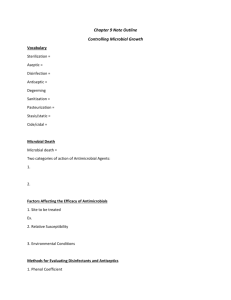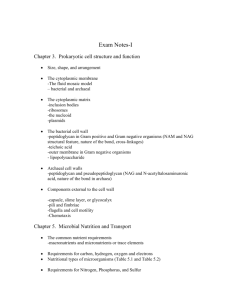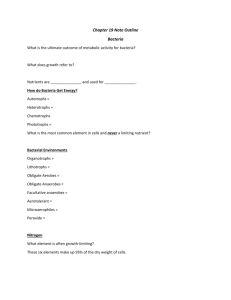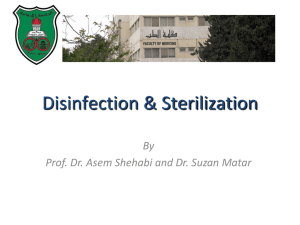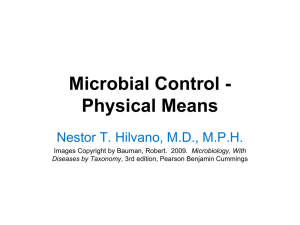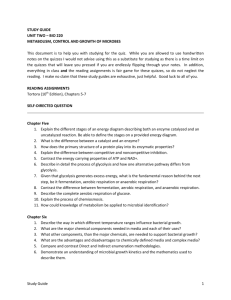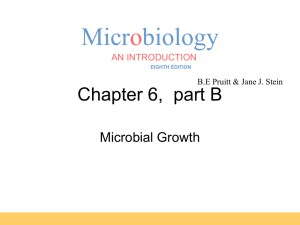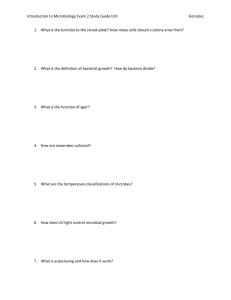Chapter 11 - WSCC Biology Tutoring
advertisement
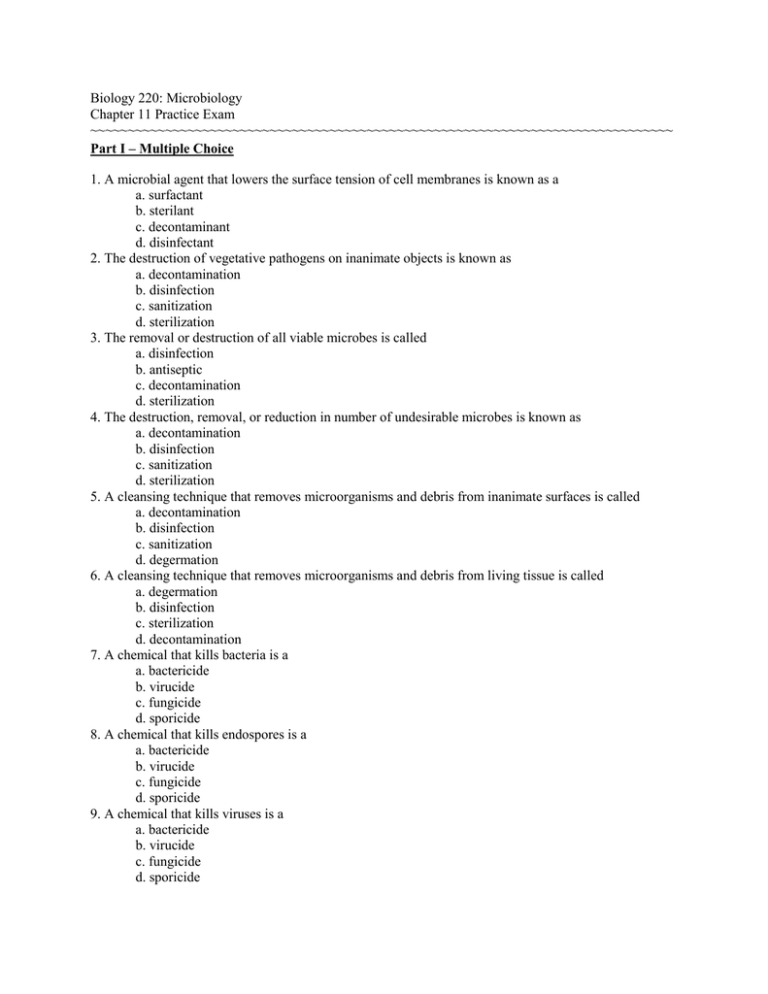
Biology 220: Microbiology Chapter 11 Practice Exam ~~~~~~~~~~~~~~~~~~~~~~~~~~~~~~~~~~~~~~~~~~~~~~~~~~~~~~~~~~~~~~~~~~~~~~~~~~~~~~ Part I – Multiple Choice 1. A microbial agent that lowers the surface tension of cell membranes is known as a a. surfactant b. sterilant c. decontaminant d. disinfectant 2. The destruction of vegetative pathogens on inanimate objects is known as a. decontamination b. disinfection c. sanitization d. sterilization 3. The removal or destruction of all viable microbes is called a. disinfection b. antiseptic c. decontamination d. sterilization 4. The destruction, removal, or reduction in number of undesirable microbes is known as a. decontamination b. disinfection c. sanitization d. sterilization 5. A cleansing technique that removes microorganisms and debris from inanimate surfaces is called a. decontamination b. disinfection c. sanitization d. degermation 6. A cleansing technique that removes microorganisms and debris from living tissue is called a. degermation b. disinfection c. sterilization d. decontamination 7. A chemical that kills bacteria is a a. bactericide b. virucide c. fungicide d. sporicide 8. A chemical that kills endospores is a a. bactericide b. virucide c. fungicide d. sporicide 9. A chemical that kills viruses is a a. bactericide b. virucide c. fungicide d. sporicide 10. A chemical that kills fungi is a a. bactericide b. virucide c. fungicide d. sporicide 11. ____________ refers to the process of mechanically removing microbes from the skin. a. disinfecting b. sterilizing c. degermation d. denaturation 12. The cellular targets of physical and chemical agents fall into four general categories. Which of the following is not a category? a. cell wall b. cell membrane c. proteins d. atp production 13. ___________ is defined as the shortest length of time required to kill all test microbes at a specified temperature. a. death time b. thermal death time c. thermal time d. time of thermal death 14. As a general rule, __________ temperatures allow _______ exposure times and ________ temperatures require ___________ exposure times. a. shorter; higher/ longer; lower b. higher; shorter/ lower; longer c. higher; longer/ lower; shorter d. shorter; lower/ longer; higher 15. Which of the following is not a way in which moist heat is employed to control microbes? a. heat b. pressurized steam c. nonpressurized steam d. pasteurization 16. Normal atmospheric pressure is a. 1 psi b. 5 psi c. 10 psi d. 15 psi 17. At normal atmospheric pressure, water will boil at a. 80 °C b. 100 °C c. 112 °C d. 210 °C 18. An autoclave is most comparable to which of the following household items? a. pressure cooker b. gas grill c. vacuum cleaner d. microwave 19. _________________ is a technique in which heat is applied to liquids to kill potential agents of infection and spoilage, while at the same time retaining the liquids flavor and food value. a. pasteurization b. tyndallization c. incineration d. radiation 20. _________________ is a process used in case a substance cannot be subjected to the high temperature of the autoclave. a. pasteurization b. tyndallization c. incineration d. radiation 21. _________________ is defined as energy emitted from atomic activities and dispersed at high velocity through matter or space. a. pasteurization b. tyndallization c. incineration d. radiation 22. Solutions containing pure water as the solvent are termed __________, whereas those dissolved in pure alcohol or water alcohol mixtures are termed ___________. a. tinctures; aqueous b. septic; aseptic c. aqueous; tinctures d. aseptic; septic 23. Which of the following is not a halogen? a. hydrogen b. chlorine c. iodine d. bromine 24. Which of the following halogens are more commonly used due to hazards and health risks of the others? a. chlorine; bromine b. chlorine; iodine c. iodine; bromine d. hydrogen; helium 25. Which of the does not describe a halogen? a. microbicidal b. microbistatic c. fungicidal d. sporicidal Part II – True or False 26. The growth of microorganisms in the tissues is called sepsis. 27. Techniques that prevent the entry of microorganisms into sterile tissues is called asepsis. 28. The removal of a protein from its natural habitat is known as denaturization. 29. The permanent loss of reproductive capability, even under optimum growth conditions, has become the accepted microbiological definition of death. 30. Microbial control methods involve the use of physical or chemical agents to eliminate or reduce the numbers of microorganisms. 31. Antiseptic agents are described according to their ability to destroy or inhibit microbial growth. 32. An antimicrobial agent is applied to living tissue to destroy or inhibit microbial growth. 33. A disinfectant agent is used on inanimate objects to destroy vegetative pathogens but not bacterial endospores. 34. Microbial death is defined as the permanent loss of reproductive capability in microorganisms. 35. Sterilization reduces microbial numbers of inanimate objects to safe levels by physical or chemical means. 36. As a general rule, chilling, freezing, and desiccation should not be construed as methods of disinfection or sterilization because their antimicrobial effects are erratic and uncertain, and one cannot be sure that pathogens subjected to them have been killed. 37. Moist heat is not as versatile or as widely used as dry heat. 38. Physical methods of microbial control include radiation, heat, cold, drying, and filtration. 39. Cold is the most widely used method of microbial control. 40. Boiling water and pasteurization of beverages disinfect but do not sterilize materials. Part III – Matching 41. 3% serves a variety of needs: skin/wound cleansing 42. 0.6-1.0 chlorine/million parts water to ensure safe drinking water 43. treat wounds, disinfect equipment, household bleach 44. alternative to treat water supplies 45. 2% iodine & 2.4% sodium iodide; used topically before surgery/burned & infected skin 46. 2% iodine and sodium iodide solution in 70% alcohol; used in skin antisepsis 47. disinfects drains/ cesspools/ animal quarters 48. common household version of a phenolic 49. obstetric antiseptic/ neonatal wash/ wound degermer/ mucous membrane irrigant/ eye preservative 50. germicidal; inexpensive; 70-95% solutions are skin/equipmt degermers a. chlorination b. Lysol c. ethyl alcohol d. iodine tinctures e. phenolics f. chlorohexidine g. hydrogen peroxide h. aqueous iodine i. chloramines j. hypochlorites
